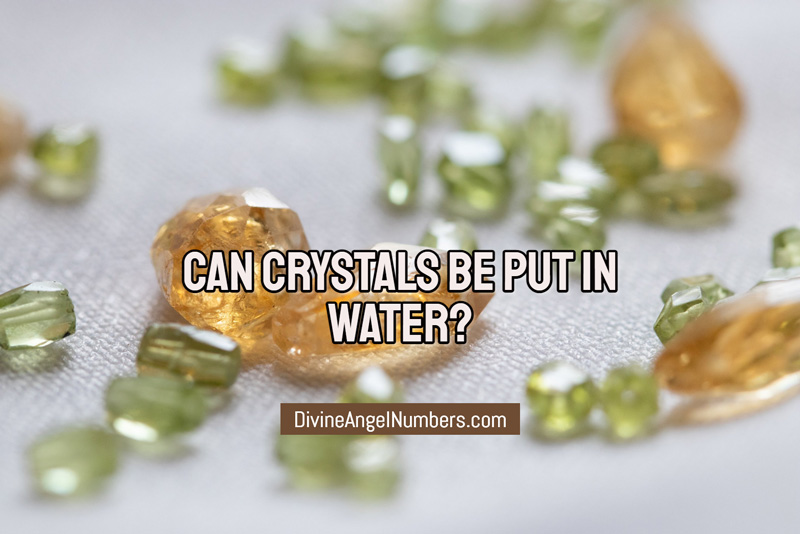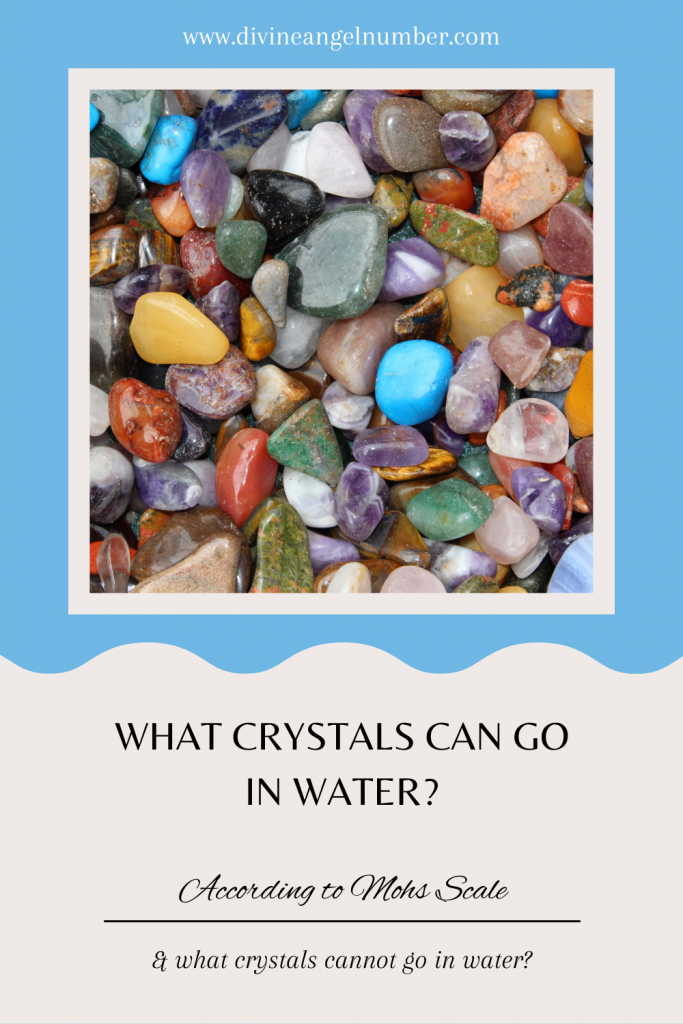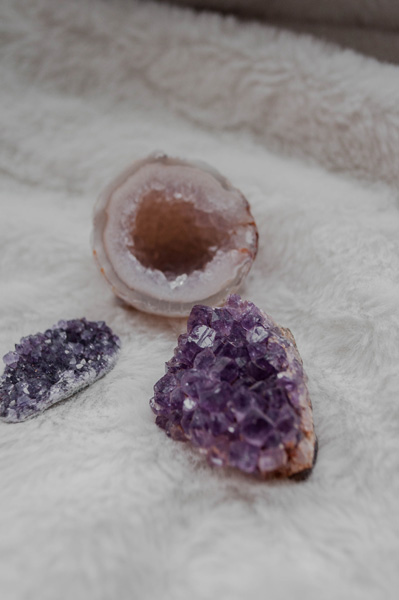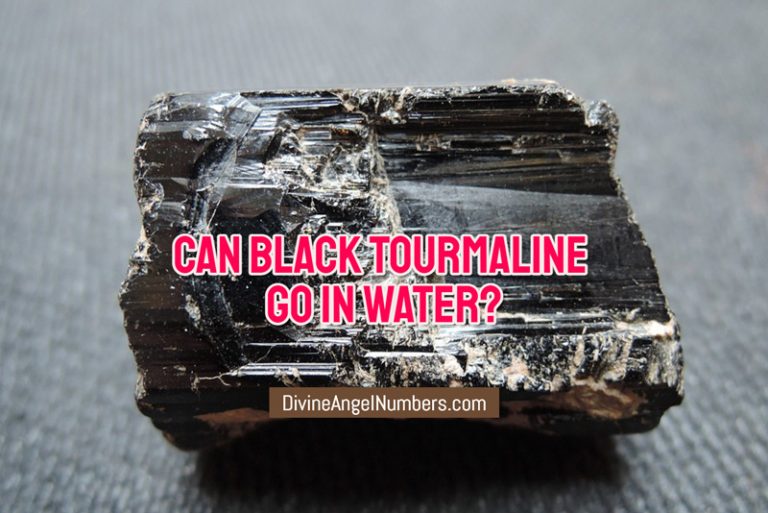Understanding what crystals can go in water is very crucial if you use crystals for healing. But before that let’s know more about these sparkling things.
The word “crystal” has been derived from the Greek word “Krustallos” meaning ‘ice’ or ‘rock crystal’. The atomic particles of a crystal are extremely tightly packed, in an organized manner.
Examples of crystals are Magnetite, Rock salt, Diamond, Ruby, Quartz, etc.
Crystals hold a lot of religious and spiritual value. They are widely used on such occasions and are the core elements required for “crystal therapy”. It is believed that certain crystals; such as; Quartz, Amethyst, Opal, etc. have healing abilities; they can repel negative energy and boost positive energy. These crystals are associated with magical effects and are a vital element in many sacred events.
- How do Crystals Look?
- What are Healing Crystals?
- How to Use Healing Crystals?
- Cleaning Healing Crystals
- How Can We Clean Healing Crystals?
- Which Crystals Should Not Be Put In The Water?
- What is the Mohs Hardness Scale?
- Which Crystals Cannot be Cleansed in Water? (on the basis of their rank on the Mohs scale)
- Other Crystals Cannot Be Put in Water
- Crystals Which Are Safe Under Water
- Frequently Asked Questions
- What Crystals Can Go In Water?
- How often should the crystals be cleansed?
- Which crystals can be cleansed with water?
- Which is the best way of cleansing crystals?
- Can Amethyst be cleansed with water?
- Can Citrine go in the water?
- Can Malachite go in the water?
- Can Opalite go in the water?
- How to charge water with crystals?
- Which crystals cannot be cleansed with salt water?
- What does Opalite do?
- What crystals purify water?
- Is Rose Quartz porous?
- Can Rose Quartz go in water?
- Can Hematite get wet?
- Can Tiger's eye go in water?
- Can Green Aventurine go in water?
- Can Amethyst go in water?
- Is Quartz soluble in water?
- Can Fluorite get wet?
- Can Sodalite go in water?
- Can Selenite get wet?
How do Crystals Look?
Crystals are recognized as matter with angular ends and flat surfaces (facets). Their microscopic structure is characterized by an organized arrangement of atomic particles in a compact manner.
Crystals are found in rocks, and ice, and are even produced organically by living organisms (e.g. Aragonite, Calcite).
What are Healing Crystals?
Healing crystals are also called semi-precious gemstones. They are naturally formed and can be found buried within the earth. Healing crystals have the ability to release positive energy and prevent negative energy from affecting us. They connect us with other elements in our surroundings and have the ability to bring peace of mind.
Crystals are said to be able to harness the energy of the sun, moon, and oceans. Healing crystals are important for one’s spiritual well-being. They help in strengthening our mind and body on a spiritual level, enhancing our aura. Healing crystals are like magnets that attract positive energy and repel negative energy. They also help in keeping us physically fit and healthy in the process.
Examples of healing crystals are Jade, Moonstone, Ruby, etc.
How to Use Healing Crystals?
As mentioned earlier, healing crystals channel our thoughts and connect us to our surroundings. While using them, we should have good intentions in our hearts. We should possess no ill-will, or keep negative thoughts and intentions.
Before using them, healing crystals should be properly cleaned so that any unwanted or negative energy is wiped out. After being cleansed, they should be kept under proper sunlight for a few hours, so that they get re-energized. One can hold a healing crystal, try to meditate, bring positive thoughts in their minds and feel themselves getting connected with other elements in nature.

Cleaning Healing Crystals
Why should we clean healing crystals?
Before reaching us, these crystals often travel long distances and change hands numerous times. Each time they are touched by a new person, they collect and reflect the energy their holder is possessing. Therefore, when the crystal finally reaches us, the first step we should follow is to cleanse it properly so that we become absolutely certain that the healing crystal is devoid of any unwanted negative energy. We should also be careful to hold them only when we concentrate on positive thoughts in our minds.
How Can We Clean Healing Crystals?
There are numerous ways to clean healing crystals. Depending on the physical properties of the healing crystals one possesses, one should carefully choose which method is the most suitable. Following are a few ways one can use to clean crystals:
Using running water
It is best to use running water from natural sources, such as streams, to clean the crystals. Running water has the ability to wash away any negative energy that the crystal might harness. While cleaning, it should be ensured that the crystal is completely submerged under water. Once it is washed thoroughly, it should be left to dry. Cleaning the crystals properly in running water for 1 minute is enough to wash away negative energy.
If natural sources of running water are not available nearby, one can use normal tap water to wash the crystals.
Using natural light
The sunlight and moonlight both can be allowed to fall on the crystal to cleanse it. However, exposing the crystal to the sun for a long duration can damage its surface. Therefore, it should be ensured that the crystal is not exposed to sunlight for long, especially near noon when the sun is brightest and the rays fall directly on the earth’s surface.
Brown rice
The crystals can be buried underneath grains of brown rice and left for a day. The crystal should then be retrieved the very next day and the grains of brown rice should be disposed of since they absorb negative energy from the crystals.
Saltwater
Saltwater from natural sources such as seas and oceans should be collected and the crystals should be kept submerged under it for at least 2 days. The salt will absorb any negative energy that the crystal might possess. If natural sources of saltwater are not available, one can add salt to normal water and continue the process.
Sound healing
Sound from bells, tuning fork, or even chanting can be used for a duration not exceeding 10 minutes to cleanse the crystals. The vibration of the sound is believed to be capable of removing any negative energy from the stone.
Breath
Small crystals can be cleansed by using one’s breath. To do so, one can hold the crystal firmly and bring it close to the nose, inhale deeply and keep on exhaling shortly but forcefully for about half a minute such that the vibration in the air cleans the crystal.
Using visualization
Holding the crystal firmly in one’s hand and visualizing it being filled with a bright white light for about a minute is said to cleanse the crystal from any negative energy.
Sage
Sage is a plant with considerable healing properties. A healing crystal can be cleaned by moving it through the smoke emerging from burning the tip of the sage plant. The process should go on for a duration of 30 to 60 sec to ensure that the crystal has been properly cleansed.
Using smaller and larger stones
Smaller stones can be placed on top of a large stone for about a day.
Similarly, larger stones can be placed in a bowl full of smaller stones and cleansed if left untouched for about a day.
This will ensure that any negative energy from the crystal is removed and it is properly cleansed in the process.
Incense Smoke
Crystal cleansing using smoke from incense is an effective way of cleaning crystals energetically and it is preferred by many people. Smoke from incense not only helps in purifying crystals, but also purifies our mind, soul, and our surroundings.
Which Crystals Should Not Be Put In The Water?
Although cleaning crystals with water is an effective method of neutralizing the negative energy they might harness, there are quite a few crystals that should not be put in water.
Crystals that are soft and can break easily should not be cleansed with running water. However, certain crystals that are hard and do not break easily might still get damaged if they are left submerged under water for a longer duration.
To be absolutely sure which crystals should not be cleansed with water, one should know about the Mohs Hardness Scale.
What is the Mohs Hardness Scale?
Mohs scale of hardness was developed by Frederich Mohs in the year 1822. It measures the relative hardness and resistance to scratching between materials. The scale is based on how strongly the atoms of a mineral are held. The stronger the bond between the atoms, the higher the mineral ranks on the Mohs hardness scale.
In short, the softest mineral will rank 1st on the scale and as it moves higher and closer to 10, the atomic bond constituting the mineral will keep on getting stronger. The mineral comprising the strongest atomic bond will land at 10 on the Mohs hardness scale.
Any crystal that ranges from 1 to 5 on the Mohs Scale of Hardness depicts a relatively weaker bond between its atoms. Therefore, they should not be cleaned with water. Such crystals will either dissolve or develop cracks if they are kept exposed to water for a longer duration of time.
Crystals that contain other minerals and have a chance of rusting when kept under water or a possibility of chemically reacting with water should not be cleansed with water under any circumstances.
The closer a crystal is to zero on the Mohs scale of hardness; the riskier it is to clean them with water. This is because the scale represents the durability and resistance of the atomic bonds by measuring their relative strength.
Crystals with weaker atomic bonds are fragile and therefore, not suitable for being cleansed under this method. One can use milder methods like sound healing, breathing, or use visualization to cleanse such crystals.
Which Crystals Cannot be Cleansed in Water? (on the basis of their rank on the Mohs scale)
| Name | Mohs Scale Ranking |
|---|---|
| Talc | 1 |
| Gypsum | 2 |
| Selenite | 2 |
| Desert rose | 2 |
| Calcite | 3 |
| Howlite | 3.5 |
| Angelite | 3.5 |
| Fluorite | 4 |
| Apophyllite | 4.5 to 5 |
| Sodalite | 5.5 to 6 |
However, the Mohs scale of hardness alone does not determine whether a crystal can be cleansed with water or not. As mentioned earlier, some crystals might release certain toxic chemicals, or start rusting if exposed to water, which will deteriorate their quality. Therefore, it is important to keep such crystals away from water.

Other Crystals Cannot Be Put in Water
Hematite
Hematite is rated around 5.5 to 6 on the Mohs scale. It is iron ore. It comprises compounds made of Iron Oxide (Fe2O3). It is common knowledge that iron starts rusting in the presence of air and water. If Hematite crystals are washed or cleansed with water, they will lose their shine over time and start rusting.
Magnetite
Magnetite too is iron ore, only better than hematite in quality. The reason why Magnetite should not be cleansed with water is the same. The crystal will lose its shine and start rusting.
Jade
Jade can be used with normal water without the use of any chemicals. However, submerging it underwater for a long time will affect its appearance, making it dull and lose its shine.
Tangerine Quartz
Tangerine Quartz gets its name from its shiny orange surface, which is made of iron ore. Tangerine Quartz rusts under water and bonds with clear quartz, giving it a bright orange color. Keeping tangerine quartz submerged under water for a long time will make it lose its shiny color.
Crystals Which Are Safe Under Water
These are water-safe crystals according to the Mohs scale ranking.
| Name | Mohs Scale Ranking |
|---|---|
| Rhodonite | 5.5 to 6.5 |
| Labradorite | 6 to 6.5 |
| Rose Quartz | 7 |
| Tiger’s eye | 6.5 to 7 |
| Aventurine | 6.5 to 7 |
| Green Aventurine | 6.5 to 7 |
| Clear Quartz | 7 |
| Amethyst | 7 |

Frequently Asked Questions
What Crystals Can Go In Water?
Crystals that have considerably higher toughness and durability, and are less brittle, i.e. crystals that range from 6 to 10 on the Mohs scale of hardness usually are safe to be cleansed with/ submerged under water. Examples are Tiger’s eye, Jasper, and all kinds of Quartz excluding Tangerine Quartz, Black Obsidian, and Amethyst.
How often should the crystals be cleansed?
There is no hard and fast rule as to how often one must cleanse the crystals. It usually depends on how often these crystals are being used. The more frequent your use, the more energy the crystal collects. Therefore, it should be cleansed as per the frequency of its use. Also, one can cleanse the crystal as and when they feel the need to do so.
Which crystals can be cleansed with water?
Crystals that are ranked high on the Mohs scale (i.e. 6 to 10) can usually be cleansed with salt water. Examples are Amethyst, Tiger’s eye, Agate, Obsidian, and all kinds of Quartz excluding Tangerine Quartz.
Which is the best way of cleansing crystals?
One can opt for any method that is the most suitable to cleanse the crystals depending on their properties. It should be kept in mind that the crystal is not damaged during the process. You can use whichever method you prefer most, the degree of effectiveness will remain the same regardless.
Can Amethyst be cleansed with water?
Amethyst ranks 7 on the Mohs scale. It is tough and durable. It does not react with water and therefore Amethyst can be cleansed with water.
Can Citrine go in the water?
Yes, Citrine can go in the water and it won’t get wet. It is a tough crystal, ranking 7 on the Mohs scale of hardness. However, keeping Citrine submerged under normal or salt water for a longer duration might cause damage to it.
Can Malachite go in the water?
Malachite ranks low (3.5 to 4) on the Mohs scale. Besides, it also contains copper ions. Keeping it exposed to water will not only damage it but is also likely to initiate a chemical reaction. It is therefore highly recommended to not cleanse Malachite crystals with water.
Can Opalite go in the water?
Opalite ranks 5 to 6 on the Mohs scale. While man-made Opalites can be cleansed with normal water, natural Opalites are soluble in hot/ salt water. Cleaning Opalites with water will damage them.
How to charge water with crystals?
To charge water with crystals, take a bowl and fill it with spring water (tap water if the former is unavailable). Leave the bowl in direct sunlight for around 4 hours along with the crystals surrounding it. It is not necessary to place the crystals inside the bowl.
After the duration is over, use visualization and imagine white light emerging from the crystals and falling on the bowl.
Once the process is complete, remove the crystals and store the water in a cool place.
Drink the water to spread positivity inside your mind and body.
Which crystals cannot be cleansed with salt water?
Crystals that cannot be cleansed with normal water cannot be cleansed with salt water also. Examples are Talc, Selenite, Calcite, etc. which range from 1 to 5 on the Mohs scale of hardness. Iron ores and crystals that might react with water also cannot be cleansed with salt water.
What does Opalite do?
Opalite, like other healing crystals, spreads positivity and drives negative energy away. It fills our minds with optimism and warmth.
What crystals purify water?
Crystals like Clear Quartz, Tumbled Clear Quartz, and Shungite can purify water.
Is Rose Quartz porous?
No, Rose Quartz is not porous. Rose Quartz can get wet.
Can Rose Quartz go in water?
Yes, Rose Quartz can be kept in water.
Can Hematite get wet?
Hematite should be kept away from water because it is an iron oxide that rusts when it comes in contact with water or kept submerged. It starts losing shine.
Can Tiger’s eye go in water?
Yes, it is perfectly safe to keep Tiger’s eye in water or clean it with water.
Can Green Aventurine go in water?
Yes, Green Aventurine can go in the water due to its hardness.
Can Amethyst go in water?
Yes, it is perfectly safe to keep Amethyst in water or clean it with water.
Is Quartz soluble in water?
No, Quartz is not soluble in water under normal temperature.
Can Fluorite get wet?
No, Fluorite should not get wet.
Can Sodalite go in water?
No, Sodalite cannot be put in water. Sodalite cannot get wet.
Can Selenite get wet?
No, Selenite cannot get wet as it has a Mohs ranking of 2



